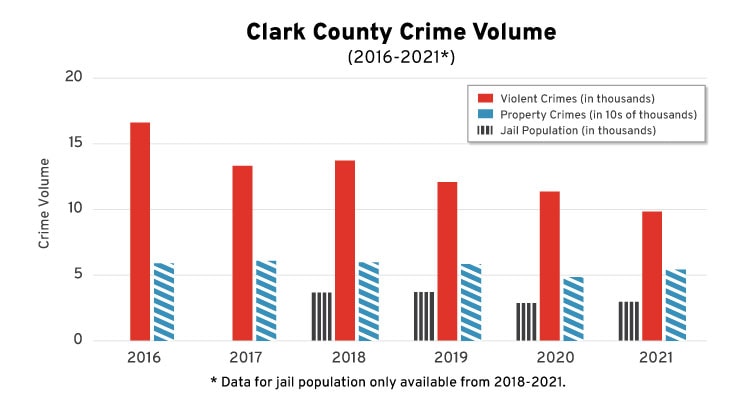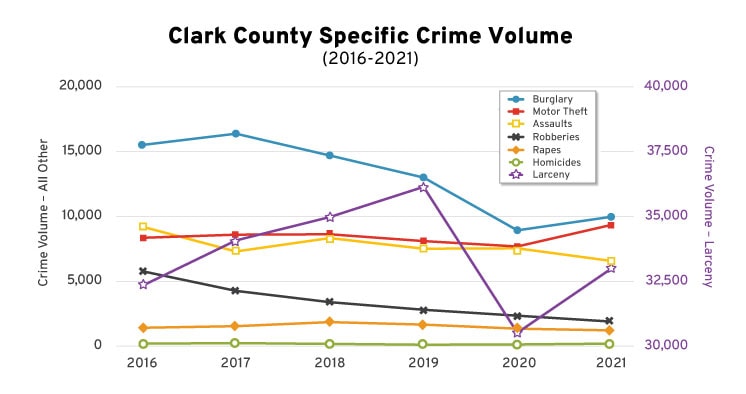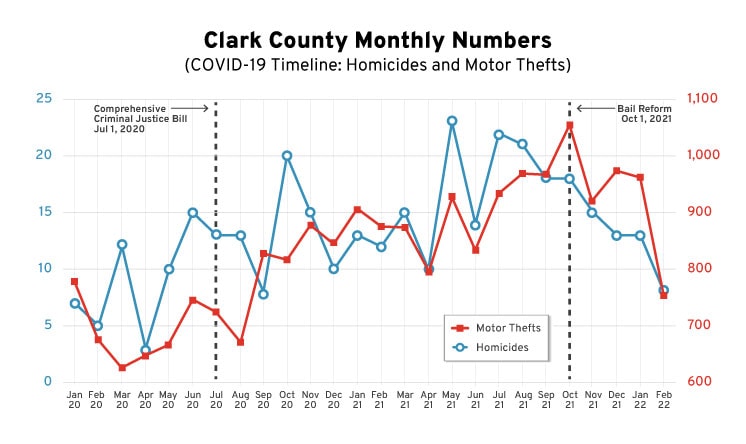Criminal Justice Reform Efforts and Rise in Crime: Spotlight on Clark County, Nev.
This is the second in a series of posts on the subject. Scroll to the end to see the most recent posts in the series.
Introduction
The nation has been captivated by reports of rising crime and the wave of criminal justice reform. Some news outlets and elected officials claim a correlation between the two, but this is perhaps a hasty assessment. In order to better understand how criminal justice reform efforts could be affecting increases in crime, we will be digging into the data, history and current criminal justice reform efforts of six Safety and Justice Challenge sites across the United States. Readers can learn about unique criminal justice reform initiatives in these communities as well as whether the implementation of these efforts (or lack thereof) could be associated with an increase or decrease in crime. To learn more about this series, you can access the introduction here.
Location Information
Clark County, Nev. is home to Las Vegas, a major resort city known for its gambling and world-class entertainment. Over two million people reside in Clark County, making it the most populated county in Nevada. Thirty-four law enforcement agencies cover Clark’s 7,891 square miles.
Crime Statistics
From 2016 to 2020, Clark County saw an overall decrease in property and violent crimes. While violent crimes continued to fall in 2021, property crimes increased. Clark County’s average daily jail population fell significantly at the beginning of the COVID-19 pandemic and has increased slightly since that time. The graph below reflects these trends.

Violent crimes have been on a steady decline for the last five years due to the significant reduction of rapes and robberies. Murders are also down from their five-year high in 2017, but did increase from 2019-2021. Notably, the increase in murders peaked in the summer of 2021 and declined every month after July; preliminary data shows this downward trend extending into 2022. Assaults are also down from their five-year high in 2018, but have fluctuated without a sustained trend. The decline in property crimes from 2017-2020 was in large part due to the significant decrease in burglaries as well as a drop in larcenies. Motor vehicle thefts saw a small decrease during that same timeframe. In 2021, burglaries, larcenies and motor vehicle thefts all increased. While motor vehicle thefts increased significantly—similar to national trends—burglaries and larcenies increased only slightly and did not reach the heights of the previous three years. Burglaries and larcenies did, however, increase on average from the summer through the end of the year in 2021. Preliminary data in 2022 shows a decline in all three property crimes. Using data from the State of Nevada, the graph below shows the year-to-year crime trends of these individual crimes.

Criminal Justice Reform Efforts
Over the past five years, Clark County has executed local criminal justice reform initiatives such as the Hope for Second Chances pre-entry program, Project Redirect pre-prosecution diversion and Law Enforcement Assisted Diversion (LEAD). Further, Nevada passed several criminal justice reform bills impacting Clark County. The three bills with the ability to reduce jail populations most significantly are highlighted below.
Comprehensive Criminal Justice Reform Bill:
In 2018, the governor of Nevada commissioned the bipartisan Nevada Advisory Commission on the Administration of Justice to identify strategies that would help reduce crime, mitigate recidivism and increase public safety. The commission analyzed many factors—increases in prison population, demographics and history of inmates, current state policies and best practices from other states—and recommended 25 policy changes. In response, Nevada passed AB236, a comprehensive criminal justice reform bill, with strong bipartisan support in 2019. The substantive reform efforts contained therein became effective July 1, 2020, and include several significant reforms:
-
Limits supervising officers from revoking parole and probation for technical violations—such as failing to pay required fines and fees or consuming an alcoholic beverage—and caps the period of imprisonment for a revocation due to a technical violation. Research has shown that 13-25 percent of prison admissions are due to technical violations of individuals on parole or probation, costing taxpayers millions of dollars. Now, instead, Nevada will subject technical violators to graduated sanctions.
-
Increases the felony theft threshold from $650 to $1,200 (value thresholds for motor vehicle thefts were removed; any vehicle theft is considered a felony). By increasing this threshold, fewer individuals will be impacted by the social repercussions—such as an inability to obtain a job or housing—a felony conviction can carry. Studies in other states that have increased the threshold show no resulting incline in theft or other property crimes.
-
Creates an option for geriatric parole for most non-violent parolees over the age of 65 who have served at least a majority of their sentence. Some studies have shown that the rate of recidivism for this population is drastically lower than average while the cost of continuing to detain these individuals is significantly higher than average.
Bail Reform:
In 2021, the Nevada State Legislature passed three bills reforming bail, in an effort to alleviate the incarceration of individuals based merely on an inability to pay:
-
AB424, effective July 1, 2022, requires the court to address pretrial release of an individual within 48 hours of arrest.
-
AB440, effective Oct. 1, 2021, requires police to issue a citation in lieu of arrest for an individual accused of non-violent, non-repeat misdemeanor offenses.
-
SB369, effective Oct. 1, 2021, requires a court to only impose bail or bail conditions with the least restrictive means necessary to ensure the appearance of the person in court and/or protect the safety of the community. Further, the prosecution is now required to show by clear and convincing evidence that the imposition of bail or a condition of bail is necessary under the same considerations.
These bills faced opposition from prosecutors and law enforcement with fears that these bail reforms would cause an increase in crime, though research actually shows that any amount of pretrial detention can increase recidivism rates and be detrimental to public safety.
Civil Traffic Infractions:
In 2021, Nevada bill AB116 was signed into law and will take effect on Jan. 1, 2023. AB116 established certain traffic violations—such as broken tail light or speeding—as civil infractions rather than criminal offenses. Previously, Nevada was only one of 13 states that still prosecuted these minor traffic violations as criminal offenses. This effort ended the practice of arresting individuals for these traffic offenses as well as those who could not afford the fines and fees imposed on minor traffic tickets. This will not only help alleviate collateral consequences of arrest—such as job loss—but also save taxpayer dollars by reducing the number of jail admissions.
These criminal justice reform efforts reduce incarceration admissions and lengths of stay. Incarceration negatively impacts mental health, physical health, housing and employment. By limiting these issues, communities can reduce the chances of recidivism. Further, governments—and thereby taxpayers—can realize immediate and long-term savings by reducing the number of individuals being processed, boarded and supervised within detention facilities.
Conclusion
Assessment of the collected data shows it is unlikely that local criminal justice reform efforts resulted in an increase in crime in Clark County.
Over the last two years, rapes, robberies and assaults declined. Burglaries and larcenies, after a decline in 2020, only increased slightly in 2021, to a level still below that of preceding years. Given these statistics, we conclude that these crimes did not increase due to reform efforts. Nevada’s law limiting arrests for traffic violations will not take effect until 2023, so their impacts in Clark County—whether positive or negative—are currently unknown.
None of these criminal justice reform efforts specifically addressed murder or crimes of violence. While rates of murder did increase as these reform efforts became effective, the average increase since the COVID-19 pandemic mimics national murder trends. The chart below shows no direct correlation between the effective date of the reform and an increase in murders.

Likewise, the criminal justice reform efforts did not directly affect motor vehicle thefts. The bail reform legislation did not include motor vehicle thefts as an offense to be cited in lieu of arrest. Similarly, the felony theft threshold was not increased for motor vehicle thefts; rather, motor vehicle theft is a felony regardless of the value of the vehicle stolen. While rates of motor vehicle theft did increase over the time period these reform efforts became effective, the chart above shows no direct correlation between the effective date of the reform and an increase in motor vehicle thefts. Like murder rates, motor vehicle rates seem to be following national trends, indicating generalized factors other than localized reforms.
Therefore, it is unlikely that the reforms caused the increase in murder or motor vehicle thefts. It would be beneficial, however, for Clark County to collect data regarding the perpetrator of these crimes. Should analysis reveal a correlation between those perpetrators and individuals affected by these reforms (those released on compassionate parole; those currently on parole or probation; or those cited instead of arrested), further analysis would be necessary.
This post will be updated with links to each part in the series.
- Criminal Justice Reform Efforts and Rise in Crime: Introduction
- Criminal Justice Reform Efforts and Rise in Crime: Spotlight on Broward County, Fla.
- Criminal Justice Reform Efforts and Rise in Crime: Spotlight on Clark County, Nev.
- Criminal Justice Reform Efforts and Rise in Crime: Spotlight on City of St. Louis, Mo.
- Criminal Justice Reform Efforts and Rise in Crime: Spotlight on Allegheny County, Pa.
- Criminal Justice Reform Efforts and Rise in Crime: Spotlight on Baton Rouge, La.
- Criminal Justice Reform Efforts and Rise in Crime: Spotlight on Missoula, Mont.
- Criminal Justice Reform Efforts and Rise in Crime: Conclusion







